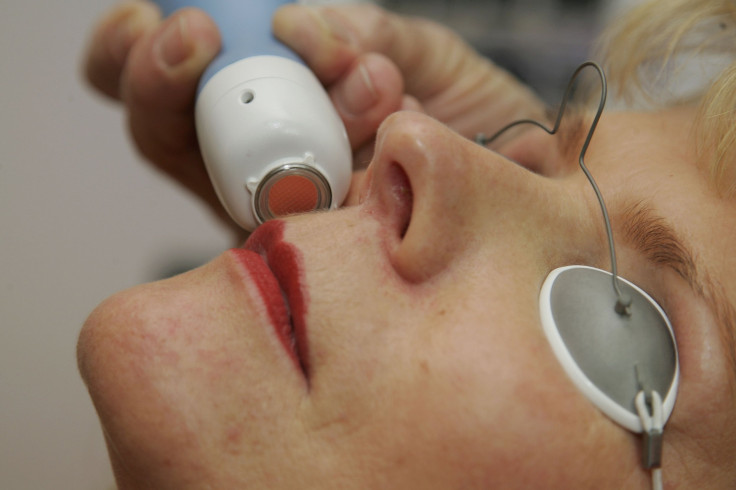What Is Rosacea? Learn About The Skin Condition On National Rosacea Awareness Month

Spring breezes may leave you with rosy cheeks, but for some people the tendency to blush more easily than others is one of the first signs of rosacea. A common skin disease, rosacea begins with a flush and then slowly spreads beyond the nose and cheeks to the forehead and chin. Even the ears, chest, and back might be touched by the rosy wand and begin to appear ruddy at all times. For April, National Rosacea Awareness Month, learn more about this poorly understood skin disorder.
Well over 16 million Americans have this skin condition, and famous sufferers include Bill Clinton, Amy Schumer, Princess Diana of Wales, and Sam Smith. Celebrity or not, it’s known to catch those it affects by surprise: A survey from the National Rosacea Society (NRS) found that the overwhelming majority of patients — 95 percent — knew little or nothing about the condition prior to their diagnosis.
Rosacea cannot be cured but it can be controlled.
Risks and Symptoms
Rosacea is believed to be hereditary, but environmental factors, including sun, stress, alcohol, and weather conditions, have their impact and may trigger the condition. While everyone and anyone, no matter their race or ethnic background, could develop rosacea, people with fair skin who tend to flush easily are most at risk. This skin condition is more frequently diagnosed in women, however it’s usually men’s lot to deal with the worst symptoms. Doctors say this is because men delay longer in getting help and so the disorder progresses to a more advanced stage.
The American Academy of Dermatology sorts rosacea into four different categories based on the combination of symptoms. Erythematotelangiectatic rosacea is signaled by redness, flushing, and visible blood vessels. Papulopustular rosacea consists of redness, swelling, and acne-like breakouts. Phymatous rosacea includes thickened skin and a bumpy skin texture. Finally, ocular rosacea will cause red and irritated eyes, swollen eyelids, and even sty-like bumps on the rim of the eye.
It is important to remember many patients will experience symptoms of more than one category at the same time. Sometimes a person’s symptoms will progress in succession through the categories. Over time many sufferers, no matter their subtype, will display permanent redness in the center of their faces. Whether or not rosacea evolves into a new category, each individual symptom can gradually worsen from mild to moderate to severe.
For this reason, dermatologists recommend early diagnosis and treatment.
Effects
Like acne, this skin condition changes a person’s appearance and so untreated rosacea often causes psychological, social, and even economic problems.
More than 90 percent of rosacea patients said their condition had lowered their self-confidence and self-esteem, one NRS survey found. Four in 10 people reported the condition had caused them to cancel going out or to avoid personal contact. Half of rosacea patients with severe symptoms said they had missed work because of their condition, while nearly 9 out of 10 said their symptoms had done harm to their professional lives.
Bad as the social problems caused by rosacea, the health effects may be worse. Research suggests people with rosacea have increased risk of cardiovascular disease, gastrointestinal disease, certain types of cancer, and other systemic illnesses.
For instance, one analysis of more than 33,000 patients with rosacea in Taiwan revealed rosacea patients had a 41 percent greater risk of high cholesterol, a 35 percent higher risk of coronary artery disease, and a 17 percent greater risk of high blood pressure than people without the condition. A study based on data from the Nurses Health Study II looked at the medical records of more than 6,000 women with the skin disorder and compared this group to women without rosacea. Women with rosacea were 1.59 times more likely to have thyroid cancer and 1.5 times more likely to have a form of skin cancer, the researchers discovered.
Other studies suggest, though none definitively prove, that rosacea may be associated with inflammatory bowel disease, allergies, respiratory diseases, gastroesophageal reflux disease (GERD), diabetes, urogenital diseases, female hormone imbalance, and a form of brain cancer.
Treatments
Though no cure exists, medical help can control the symptoms of this disorder.
Dermatologists prescribe various oral and topical medications to get rid of the bumps and pimples, while ointments can reduce redness. Generally, doctors will attempt to bring the condition under immediate control by prescribing strong oral and topical therapies, and then from there they will attempt to maintain remission with long-term topical treatments. Ocular rosacea, in particular, may be treated with oral antibiotics. In the most aggressive situations, dermatologists will use lasers, intense pulsed light sources, or other medical and even surgical devices to remove visible blood vessels, reduce extensive redness, or correct disfigurement of the nose.
It is important that a patient talk with their doctor about skin-care. Dermatologists advise patients to clean their face with a mild and non-abrasive cleanser, rinse with lukewarm water, and then blot the face dry with a towel. This regimen can be followed with non-irritating skin-care products, including sunscreen with an SPF of 15 or higher.
Finally, rosacea sufferers find it helpful to identify their triggers — the lifestyle or environmental factor that sets off their condition — in order to maintain control. The NRS lists sun exposure, emotional stress, hot weather, wind, heavy exercise, alcohol, hot baths, cold weather, spicy foods, and humidity as the top 10 triggers; that said, each patient is an individual and reacts as one. Taking note of your unique set of triggers, you can do your best to avoid them in the future.



























